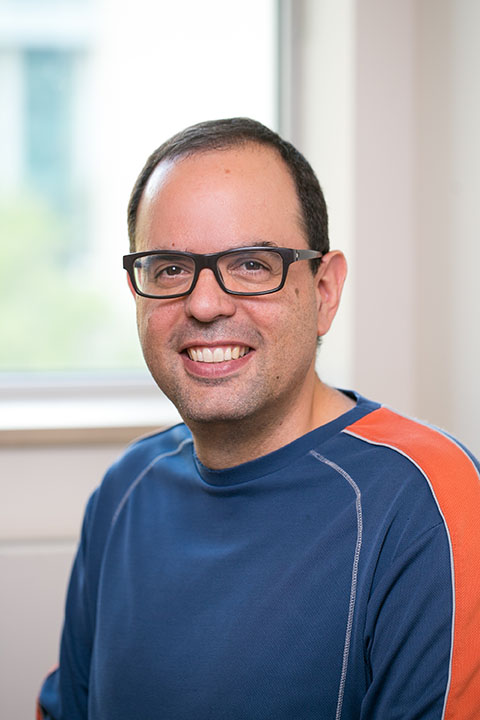Dr. Paolo Mazzotta
Role at the CentreHome-care doctor Home-care Education Supervisor Year started at the Centre2014 Shares a practice with | There is no easily defined path into palliative care. I’m frequently surprised by the answers I get when I ask Latner Centre physicians how they came to palliative care. No two doctors have ever given me the same answer. In Dr. Paolo Mazzotta’s case, the impetus came because he “didn’t feel comfortable with managing symptoms”. He was doing his Family Medicine residency at Toronto Western Hospital, a lucky choice for him, he says, because at Western “they have you follow your patients throughout your residency”. One of the problems that kept cropping up was his patients’ unmanaged symptoms. “Symptoms like nausea,” he says. “I just wasn’t comfortable managing them.” My preceptor suggested it might be helpful to do some palliative care work, since symptom management is an important aspect of palliative care. So Paolo enrolled in an elective at Mount Sinai Hospital. “At that time, Drs. Ernie Michel and Anne Langlois were doing palliative care consultations at the hospital. They were fabulous, they were really a great introduction to the concept of palliative care. They certainly opened my eyes to what it’s about.” He liked it so much he did a second elective with Dr. Christa Jenny at St. Joseph’s Hospital in Etobicoke. “That ended up being the elective that pushed me to do this. She was doing home-based care. Once I saw what she did, home-based care specifically, I said, okay this is it. This is what I’d love to do. I’d say those were the two defining moments for me.” He’s been at the Latner Centre since 2014 and the fire first kindled by Christa Jenny at St. Joseph’s is still burning brightly, he says. “Medicine is starting to wake up, to remember that people’s care should be in their homes whenever possible. Of course, not everybody has a home but it’s about where the patient is at. Can we, in the moment, provide care for someone where they’re at? As opposed to them physically coming to you? I realize more and more, doing this care, that it’s one of the bigger strains for patients, the decision-making around getting themselves to the hospital or clinic. Okay, they need treatment. That means they have to go to hospital or clinic at this time, then they have to wait to be seen, they may have to stay there, park, arrange for somebody to accompany them, etc. All these logistics create a lot of stress for patients and a lot of stress for us trying to help them organize it. So whatever we can do to bring our care to them, that’s optimal care." And it opens physicians up to dimensions of the patient they wouldn’t otherwise see, I observe. “Yes, that’s the key point. I always say that the strangest look I ever get is when I thank my patients at the end of my visit. They often respond with a “no, no, thank you.” Because they think I’m going out of my way, so they should be thanking me. But it’s the other way around. They’ve opened up their life to me and they’ve taken time out of their day, family members may have taken time off work, people in their busy day trying to care for this sick person at home. And they have made time for me. I think they get it once they understand why I’m saying thank you to them.” It’s an unassuming approach, but one that suits him. “I’ve never been a person who liked the spotlight. So it’s comfortable for me to tell patients that I’m not anyone special. I’m someone who can access care for you and help you with your problems and support you. But beyond that there’s nothing unique about me compared to you. You’re suffering and I can be a support if you need it. That’s natural for me.” This empathy for his patients seems deeply embedded. As we talk, it continues to come up, this concern for families: the people supporting the patient. “They’re the ones running around, the ones still in the rat race of their lives. And now, with all these pressures, they’re being asked to take care of something they sometimes have no experience with. Even if they do, each experience is unique, unique things that come up.” His response is to try to slow things down. To spend time with his patients and caregiver(s) to explain things. “Medicine in general can be very algorithmic, very linear. In palliative care we’re not linear. We have to follow the lead of the patient and the caregiver(s). I always reflect back to patients and their families and say “you’re the expert here, I’m not the expert, you’re the expert, it’s your body. You know what’s happening best. I’m here to troubleshoot and to be a support. “And I have to say people really appreciate that idea. “ |





